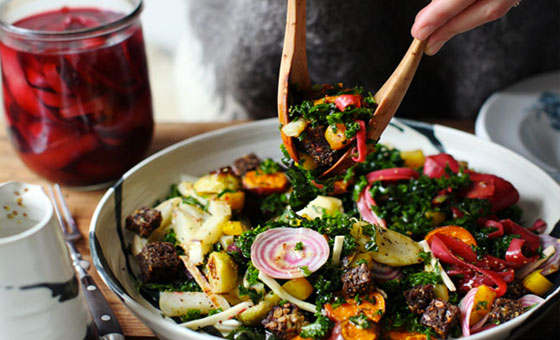I have been teaching for more than thirty years that we should eat according to the tradition of our ancestors, in addition to other concepts.
Much of my work was based on a book I read in 1967 called Nutrition and Physical Degeneration,by Weston Price, a dentist.
Dr. Price traveled the world over in the early ‘30’s, studying the diets of eleven different population groups and the condition of their teeth.
He found universally that those peoples who lived on their native diets had fine teeth, well-developed dental arches, and easy childbirth; those who had adopted the refined food of Western civilization (sugar, white flour, canned vegetables, jams and pastries) found themselves with a steep rise in dental problems, difficulty with childbirth, and crowded teeth and malformed jaws in the children of mothers who ate this way.
The Price-Pottenger Foundation has kept this important work in print all these years.
The work of Sally Fallon and Mary Enig, Ph.D., is firmly based on Dr. Price’s material. I first encountered them through an article in Health Freedom News in September 1995, called “Soy Products for Dairy Products? Not so Fast . . .”
This article sent shockwaves through the school, and we spent some time discussing it.
In essence, what Fallon and Enig say is that soybeans, as other grains and beans, are high in enzyme inhibitors which “block the action of trypsin and other enzymes needed for protein digestion . . . (These inhibitors) can produce serious gastric distress, reduced protein digestion, and chronic deficiencies in amino acid uptake. . . . The soybean also contains hemagglutinin, a clot-promoting substance that causes red blood cells to clump together.
Trypsin inhibitors and hemagglutinin have been rightly labeled “growth depressant substances.” Second generation Japanese in America grow taller than their native ancestors, and that may be because of the reduced phytate content of the American diet.
“Asian children who do not get enough meat and fish to counteract the effects of a high phytate diet frequently suffer rickets, stunting, and other growth problems,” Fallon and Enig contend.
In addition, they write, “soybeans are high in phytic acid or phytates.” This organic acid, present in all seeds and grains, blocks the uptake of minerals such as calcium, magnesium, iron, and especially zinc. The trypsin inhibitors and the phytates are deactivated with soaking and fermentation, but not as much with cooking or precipitating.
For both reasons, then, tofu and soy milk are not such good food choices, as they both are high in trypsin inhibitors and phytates; the best soy foods in this regard are naturally fermented soy sauce or shoyu, miso, tempeh, and natto.
Fallon and Enig point out that traditionally, the Japanese consume tofu with a mineral-rich fish broth (or miso soup, from my experience), which helps counter their negative effects, as animal protein reduces the mineral-blocking effects of the phytates.
While many people are allergic to milk, allergies to soy products are almost as common. Turning to imitation dairy products made from soy (soy milk, soy cheese, soy yogurt) may therefore not be such a good idea, both because of phytates and because of their allergenic potential.
I have always felt uncomfortable with these highly processed, unnatural foods, so I was pleased to find Fallon and Enig confirmed my viewpoint.
Phytates, incidentally, may affect thyroid function: one young woman I saw for a consultation who was pale, wan, losing her hair, and complaining of headache, severe dizziness, and eye problems, all symptoms of thyroiditis, said her symptoms were gone in four days after she abandoned her daily tofu and tempeh.
Even her thyroid gland, which had been noticeable before, went down in size.
Fallon and Enig are co-authors, with Patricia Connolly, of a book that should be next to Price’s in any well-stocked health library: Nourishing Traditions: The cookbook that challenges politically correct nutrition and the diet dictocrats(ProMotion Publishing, San Diego, CA: 1995). In a nutshell, these are some of the basic concepts in this book:
-
Nourishing traditional foods include those that our ancestors ate: fresh, organically raised meats, fowl, eggs; organ meats such as liver and kidneys from healthy animals; seafood from deep sea waters; fish eggs; fermented soy and milk products; raw, cultured butter and cream from healthy cows; extra virgin olive oil, small amounts of flax, coconut, and other unrefined tropical oils. Fats from healthy, organically raised animals are prized because of their essential fatty acid and fat-soluble vitamin content; many studies show that in traditional natural food diets animal fats are associated with a lower rate of heart disease.
-
To inactivate the phytates, whole grain products and beans should be soaked for eight hours in acidulated water before cooking. They recommend adding two tablespoons of whey to each cup of soaking water, but I found that one tablespoon raw balsamic vinegar or umeboshi vinegar also work. Nuts should be soaked the same way and dried in a very low oven rather than consumed raw or toasted.
-
Mineral-rich gelatinous stocks and broths should be an integral part of our cooking repertoire. This used to be common, as when people ate jellied dishes like aspic, calf’s foot jelly, oxtail stew, bird’s nest soup, pig’s head, and the like. While our current dietary customs rarely include these, it would not be difficult for us to make sure we always have a supply of vegetable, chicken, fish, or meat stocks in the freezer, and use these to enrich all our soups, sauces, grain, and bean dishes. The fanciest chefs in the most high-toned restaurants always use scraps and leftovers to make nutritious, mineral-rich stocks just like our grandmothers did.
-
Naturally fermented vegetables such as pickles and sauerkraut are recommended as regular side dishes to aid in the digestion of grains, beans, and protein.
The most controversial aspect of Fallon and Enig’s work is that they recommend the regular consumption of butter, tropical fats like coconut oil, full fat milk products, fowl, game, beef, and organ meats.
However, they do make a very strong case about the importance of organically and naturally raised animals, and that the poor diet, crowded conditions, antibiotics, steroids, and other drugs of the commercial animal industry makes commercial animal protein and fats as unhealthy as claimed.
I believe Fallon and Enig do have a point: cancer, heart disease, osteoporosis, immune disorders, and other degenerative diseases have been rising during this century, when the consumption of refined, processed, chemicalized, commercially produced foods and animals raised on mega-farms has increased dramatically.
When Dr. Price studied traditional societies that lived on natural meats, fats, fermented grains, and vegetables, he did not find any of those health problems.
I believe there are a lot of valuable ideas in Fallon and Enig’s work.
Even if you are a vegan, the practice of soaking and fermenting grains, beans, nuts, seeds, and vegetables, and cooking with vegetable stocks, can only increase the digestibility and nutritional content of your meals.
I found that adding a piece of kombu to the stock, or a tablespoon of agar to the soup, will add valuable minerals without the need for animal products.
Try some of these techniques, as we did at the school, and see for yourself. Soaked and dried walnuts are an unexpected treat!
Here is a recipe for fermented pineapple from Nourishing Traditions that I absolutely love.
PINEAPPLE CHUTNEY – Makes 1 quart
1 small pineapple, peeled, core removed, cubed
1 bunch cilantro, coarsely chopped
1 tablespoon freshly grated ginger
2 tablespoons fresh lime juice
1 teaspoon sea salt
1/4 cup whey (obtained by putting organic plain yogurt in a cheese-cloth lined colander and allowing the whey to drip out for 24 hours)
1/2 cup filtered or spring water
1. Mix pineapple, cilantro, and ginger and place in a quart-sized wide mouth mason jar. Press down with a wooden spoon or pounder.
2. Mix lime juice, seasalt, whey, and water, and pour over the pineapple mixture. Add more water if needed to cover. Cover tightly. Keep at room temperature for 2 days, when it’s ready; then transfer to refrigerator. Should be eaten within a month.

